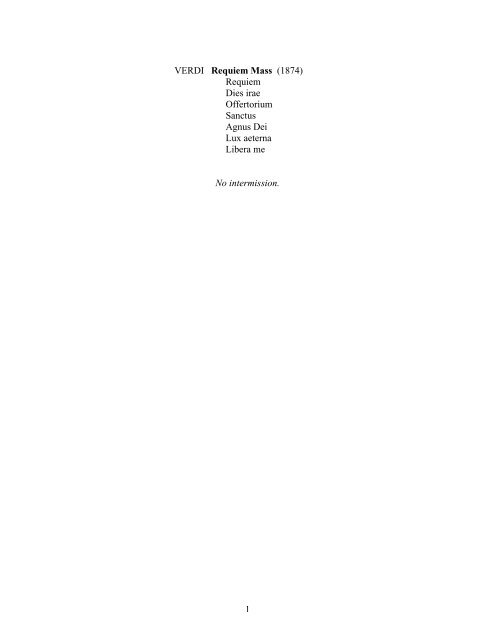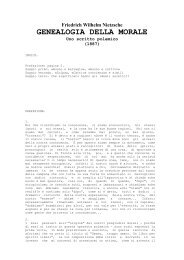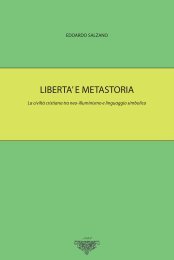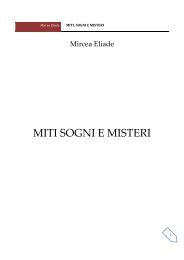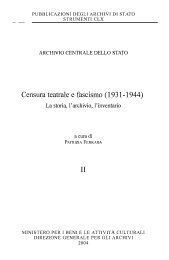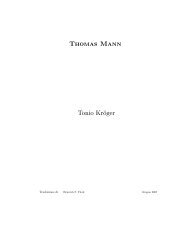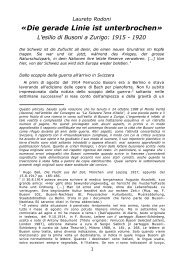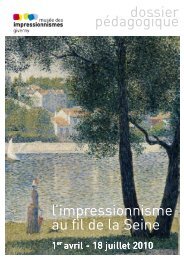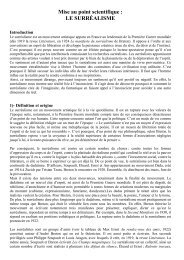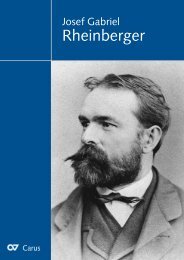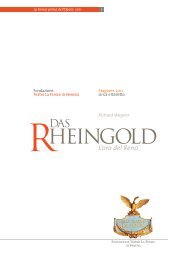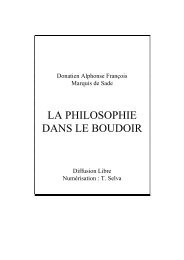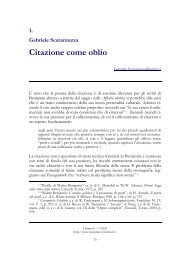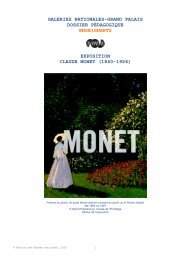1 VERDI Requiem Mass (1874) Requiem Dies irae Offertorium ...
1 VERDI Requiem Mass (1874) Requiem Dies irae Offertorium ...
1 VERDI Requiem Mass (1874) Requiem Dies irae Offertorium ...
Create successful ePaper yourself
Turn your PDF publications into a flip-book with our unique Google optimized e-Paper software.
<strong>VERDI</strong> <strong>Requiem</strong> <strong>Mass</strong> (<strong>1874</strong>)<br />
<strong>Requiem</strong><br />
<strong>Dies</strong> <strong>irae</strong><br />
<strong>Offertorium</strong><br />
Sanctus<br />
Agnus Dei<br />
Lux aeterna<br />
Libera me<br />
No intermission.<br />
1
Messa da <strong>Requiem</strong><br />
GIUSEPPE <strong>VERDI</strong> (1813-1901)<br />
Fiercely independent and passionately patriotic, Verdi revered few men as great or saintly.<br />
At the top rung of the ladder of greatness he placed only two names, Rossini and Manzoni, and it<br />
was the deaths of these two that led to the composition of his incomparably beautiful version of<br />
the Latin <strong>Requiem</strong> <strong>Mass</strong>.<br />
Gioacchino Rossini, of course, was world famous as composer of numerous Italian operas.<br />
Verdi respected him as the creator of such masterpieces as The Barber of Seville. After Rossini<br />
died, Verdi wrote that "His reputation was one of the glories of Italy. When the other that is like<br />
it [that is, Manzoni's life] exists no more, what will remain to us?"<br />
His other idol, the Italian poet Alessandro Manzoni, was author of the novel I promessi<br />
sposi ("The Betrothed"), which had done much to unite linguistically the fragmented regions of<br />
Italy. As Steven Ledbetter has written, "Inspired in its architecture by the historical novels of Sir<br />
Walter Scott, Manzoni's book easily surpasses them in scope, characterization, feeling for the<br />
forces of history, and beauty of language." By selecting the Tuscan dialect as most representative<br />
of Italy as a whole and using that dialect with such persuasively poetic beauty in his novel,<br />
Manzoni did as much in his way to promote the cause of Italian unification as all the soldiers and<br />
statesmen did in theirs.<br />
Immediately after Rossini's death in 1868, Verdi conceived a plan to honor his memory: a<br />
<strong>Requiem</strong> <strong>Mass</strong>, each of whose thirteen sections would be composed by a different Italian<br />
composer, the composite work to be given in Bologna on the first anniversary of Rossini's death.<br />
The plan was doomed. Petty jealousies and official indifference combined to assure that the<br />
"Rossini" <strong>Requiem</strong> would not be performed as planned. Verdi was humiliated and bitterly<br />
disappointed in his countrymen.<br />
Five years later Manzoni died at the age of 88. Verdi stayed away from the public funeral,<br />
paying his respects privately at the grave in Milan a few days later. Again he thought of a<br />
<strong>Requiem</strong> <strong>Mass</strong> to memorialize the deceased. "It is a heartfelt impulse, or rather necessity, that<br />
prompts me to do honor as best I can to that Great One whom I so much admired and venerated<br />
as a man."<br />
His plan was presented through his publisher to the mayor of Milan, Manzoni's home city<br />
and Verdi's adopted home as well: Verdi would write the <strong>Requiem</strong> (all of it himself this time)<br />
and bear the cost of copying the parts, if the city of Milan would pay for the performance. The<br />
terms were accepted, Verdi finished the <strong>Requiem</strong> with slightly over a month to spare, and the<br />
"Manzoni" <strong>Requiem</strong> (as it is often called) was performed in the Church of St. Mark on May 27,<br />
<strong>1874</strong>, the first anniversary of Manzoni's death.<br />
Many musicians and church officials have worried about whether this is truly a sacred<br />
work or an opera in disguise. It is obvious that Verdi, raised as a Catholic but shunning<br />
organized religion in his maturity, wrote not a dark, mystical, liturgical setting but a glowing,<br />
dramatic depiction, not an aid to worship but a memorial concert work, and one that concentrates<br />
less on thoughts of the dead than on prayers for the well-being of the living. Although he stayed<br />
closer to the prescribed text than did Berlioz, for instance, he was not above repeating portions of<br />
the text in unconventional ways when it suited his dramatic purpose.<br />
The music in this <strong>Requiem</strong> actually had its beginning in the aborted "Rossini" <strong>Requiem</strong>,<br />
2
especially the "Libera me" that Verdi composed as his own contribution to that composite work.<br />
To a professor at the Milan Conservatory he later admitted that he had also made some sketches<br />
for a "<strong>Requiem</strong> aeternam" movement and a "<strong>Dies</strong> <strong>irae</strong>," although he said he didn't expect then to<br />
finish a complete <strong>Requiem</strong>. With the impetus provided by Manzoni's passing, however, he used<br />
these sketches and a thorough reworking of the "Libera me" as starting points for his "Manzoni"<br />
<strong>Requiem</strong>. Apparently, only the opening chants of the "Libera me" and its choral fugue were<br />
retained intact from the earlier, "Rossini" version.<br />
In composing the work, Verdi had the advantage of studying earlier settings of the<br />
<strong>Requiem</strong> text. His "<strong>Dies</strong> <strong>irae</strong>" especially, with its trumpet of doom multiplied in echoing<br />
profusion, owes much to the Berlioz version, just as the later War <strong>Requiem</strong> of Britten would<br />
benefit from the example of Verdi. But where Berlioz's <strong>Requiem</strong> seems representative of French<br />
state occasions, a grand paean to national gloire, Verdi's has a particularly Italian coloration, with<br />
its multitude of wonderful melodies, its solos and ensembles addressing prayers for the dead and<br />
the living in a most personal way. The Berlioz <strong>Requiem</strong> was designed for the vast reverberant<br />
spaces of a cathedral, but Verdi's, though written for premiere in a church, seems tailored more<br />
for theatrical performance. This <strong>Requiem</strong>, which Brahms said "could be done only by a genius,"<br />
stands as a sublime tribute to the greatness of both Manzoni and Verdi.<br />
—————————————————————————<br />
REQUIEM MASS<br />
The text as set by Verdi<br />
I. REQUIEM<br />
Muted strings introduce the Introit, setting the stage for choral petitions of eternal light for the<br />
deceased. The Psalm verse "Te decet hymnus" gets unaccompanied polyphonic treatment, and<br />
there is a brief, liturgically proper repetition of the opening lines before the "Kyrie" portion, in<br />
which the soloists are first heard. Interestingly, Verdi ends by returning to the middle line of text,<br />
"Christe eleison," and the movement closes softly as violins ascend, carrying the prayers<br />
heavenward.<br />
Chorus<br />
<strong>Requiem</strong> aeternam dona eis, Domine, Grant them rest eternal, Lord,<br />
et lux perpetua luceat eis. and may perpetual light shine on them.<br />
Te decet hymnus, Deus in Sion, A hymn to you is fitting, God of Zion,<br />
et tibi redettur votum in Jerusalem, and to you shall a vow be made in Jerusalem.<br />
exaudi orationem meam, Listen to my prayer;<br />
ad te omnis caro veniet. unto you all flesh shall come.<br />
<strong>Requiem</strong> aeternam dona eis, Domine, Grant them rest eternal, Lord,<br />
et lux perpetua luceat eis. and may perpetual light shine on them.<br />
Solo Quartet and Chorus<br />
Kyrie eleison; Lord, have mercy.<br />
Christe eleison; Christ, have mercy.<br />
3
Kyrie eleison. Lord, have mercy.<br />
II. DIES IRAE<br />
As with the Berlioz <strong>Requiem</strong>, this one too has as its most prominent feature the dramatic<br />
pictorialism of the Sequence, "<strong>Dies</strong> <strong>irae</strong>." Verdi uses hammer strokes from the brass and bass drum<br />
to make quite literal the destruction of the world on that "day of wrath." (The composer directs that<br />
the bass drum be stretched very tight, so that its off-beat strokes will sound short and powerful.)<br />
Echoing trumpets, some separated off-stage, herald the Judge's arrival, and ominous choral<br />
repetitions of "<strong>Dies</strong> <strong>irae</strong>" punctuate the solo bass's description of the Judgement. Twice during the<br />
course of this long poem (which Verdi, unlike Mozart and Berlioz, sets as one continuous<br />
movement), the opening strokes and cries of doom return, making the following entreaties for<br />
salvation all the more poignant.<br />
Chorus<br />
<strong>Dies</strong> <strong>irae</strong>, dies illa, Day of wrath, that day<br />
solvet saeclum in favilla, the world will dissolve in ashes,<br />
teste David cum Sibylla. as witness David and the Sibyl.<br />
Quantus tremor est futurus, What trembling there will be,<br />
quando judex est venturus, when the judge shall come<br />
cuncta stricte discussurus. to examine all things thoroughly.<br />
Tuba mirum spargens sonum, The trumpet, spreading its wondrous sound<br />
per sepulchra regionum, through the tombs of all regions,<br />
coget omnes ante thronum. will gather all before the throne.<br />
Bass Solo<br />
Mors stupebit et natura, Death will be stupefied, also nature,<br />
cum resurget creatura, when all creation arises<br />
judicanti responsura. to answer to the judge.<br />
Mezzo-Soprano Solo and Chorus<br />
Liber scriptus proferetur, A written book will be brought forth,<br />
in quo totum continetur, in which everything shall be contained,<br />
unde mundus judicetur. by which the world shall be judged.<br />
Judex ergo, cum sedebit, When the judge is therefore seated,<br />
quidquid latet, apparebit, whatever is hidden will be exposed;<br />
nil inultum remanebit. nothing shall remain unavenged.<br />
Chorus<br />
<strong>Dies</strong> <strong>irae</strong>, dies illa, Day of wrath, that day<br />
solvet saeclum in favilla, the world will dissolve in ashes,<br />
teste David cum Sibylla. as witness David and the Sibyl.<br />
4
Soprano, Mezzo-Soprano and Tenor Solos<br />
Quid sum miser tunc dicturus, What am I, a miserable one, to say then?<br />
quem patronum rogaturus, What patron shall I request,<br />
cum vix justus sit securus? when the righteous are scarcely secure?<br />
Solo Quartet and Chorus<br />
Rex tremendae majestatis, King of fearful majesty,<br />
qui salvandos salvas gratis, who freely saves the redeemed,<br />
salva me, fons pietatis. save me, fount of mercy.<br />
Soprano and Mezzo-Soprano Solos<br />
Recordare Jesu pie, Remember, merciful Jesus,<br />
quod sum causa tuae viae, that I am the cause of your journey;<br />
ne me perdas illa die. do not abandon me on that day.<br />
Quaerens me, sedisti lassus, Seeking me, you sat down exhausted;<br />
redemisti crucem passus, you redeemed me by suffering the cross.<br />
tantus labor non sit cassus. Such great labor should not be in vain.<br />
Juste judex ultionis, Just judge of vengeance,<br />
donum fac remissionis, make the gift of remission<br />
ante diem rationis. before the day of accounting.<br />
Tenor Solo<br />
Ingemisco, tanquam reus, I sigh as one accused;<br />
culpa rubet vultus meus, shame reddens my face.<br />
supplicanti parce, Deus. Spare the supplicant, God.<br />
Qui Mariam absolvisti, You who absolved Mary [Magdalene]<br />
et latronem exaudisti, and listened to the thief<br />
mihi quoque spem didisti. have given me hope also.<br />
Preces meae non sunt dignae, My prayers are not worthy,<br />
sed tu bonus fac benigne, but you, good one, be merciful,<br />
ne perenni cremer igne! lest I burn in everlasting flames!<br />
Inter oves locum praesta, Place me prominently among your sheep,<br />
et ab haedis me sequestra, and from the goats separate me,<br />
statuens in parte dextra. placing me in the portion on the right.<br />
Bass Solo and Chorus<br />
Confutatis maledictis, Silencing the accursed,<br />
flammis acribus addictis, to acrid flames consigning them,<br />
voca me cum benedictis. call me with those blessed.<br />
Oro supplex et acclinis, I pray, bowed and kneeling,<br />
5
cor contritum quasi cinis, my heart contrite as ashes;<br />
gere curam mei finis. take care of me at the last.<br />
Chorus<br />
<strong>Dies</strong> <strong>irae</strong>, dies illa, Day of wrath, that day<br />
solvet saeclum in favilla, the world will dissolve in ashes,<br />
teste David cum Sibylla. as witness David and the Sibyl.<br />
Solo Quartet and Chorus<br />
Lacrymosa dies illa, That tearful day,<br />
qua resurget ex favilla, when guilty man shall rise<br />
judicandus homos reus. from the embers to be judged.<br />
Huic ergo parce Deus. Oh, therefore spare him, God.<br />
Pie Jesu Domine, Merciful Lord Jesus,<br />
dona eis requiem. Amen. grant them rest. Amen.<br />
III. OFFERTORIUM<br />
The Offertory, "Domine Jesu Christe," is reserved for the soloists. A highlight among the many<br />
splendid moments of vocal beauty is the soprano's first entrance, a long note held while a pair of<br />
violins previews the melody she will sing in describing Saint Michael the Standardbearer. The<br />
piece dies out in a shimmer of strings.<br />
Solo Quartet<br />
Domine Jesu Christe, Rex gloriae, Lord Jesu Christ, glorious King,<br />
libera animas omnium fidelium free the souls of all the faithful dead<br />
defunctorum de poenis inferni from punishment in the inferno,<br />
et de profundo lacu. and from the deep pit.<br />
Libera eas de ore leonis, Deliver them from the lion's mouth,<br />
ne absorbeat eas tartarus, lest the abyss swallow them up,<br />
ne cadant in obscurum: lest they fall into darkness.<br />
Sed signifer sanctus Michael But may the standardbearer St. Michael<br />
repraesentet eas in lucem sanctam, bring them into the holy light,<br />
quam olim Abrahae promisisti as once you promised to Abraham<br />
et semini ejus. and his seed.<br />
Hostias et preces tibi, Sacrifices and prayers we offer<br />
Domine, laudis offerimus. to you, Lord, with praise.<br />
Tu suscipe pro animabus illis, Receive them for the souls of those<br />
quarum hodie memoriam facimus; whom today we commemorate;<br />
Fac eas, Domine, make them, Lord,<br />
de morte transire ad vitam, to pass from death to life,<br />
quam olim Abrahae promisisti as once you promised to Abraham<br />
6
et semini ejus. and his seed.<br />
Libera animas omnium fidelium Free the souls of all the faithful dead<br />
defunctorum de poenis inferni. from punishment in the inferno.<br />
Fac eas de morte transire ad vitam. May they pass from death to life.<br />
IV. SANCTUS<br />
For the "Sanctus," the chorus is divided into eight parts, sometimes woven together in counterpoint,<br />
sometimes divided as two four-part choruses in antiphonal opposition. Following the lead of Luigi<br />
Cherubini's <strong>Requiem</strong>, Verdi combines the "Sanctus" and "Benedictus" into one seamless<br />
movement, beginning and ending in celestial glory.<br />
Choruses I and II<br />
Sanctus, sanctus, sanctus, Holy, holy, holy,<br />
Dominus Deus Sabaoth. Lord God of the Hosts.<br />
Pleni sunt coeli et terra The heavens and earth are filled<br />
gloria tua. with your glory.<br />
Hosanna in excelsis. Hosanna in the highest.<br />
Benedictus, qui venit Blessed is he who comes<br />
in nomine Domini. in the name of the Lord.<br />
Hosanna in excelsis! Hosanna in the highest!<br />
V. AGNUS DEI<br />
The two female soloists begin the "Agnus Dei," singing unaccompanied in octave unison and<br />
echoed by the unison chorus. As the text is repeated, the orchestra joins the singers, and the chorus<br />
begins to add harmony. The atmosphere throughout is one of simplicity and pathos.<br />
Soprano and Mezzo-Soprano Solos and Chorus<br />
Agnus Dei, Lamb of God,<br />
qui tollis peccata mundi, who removes the world's sins,<br />
dona eis requiem. grant them rest.<br />
Agnus Dei, Lamb of God,<br />
qui tollis peccata mundi, who removes the world's sins,<br />
dona eis requiem sempiternam. grant them rest everlasting.<br />
VI. LUX AETERNA<br />
These closing words of the <strong>Mass</strong> for the Dead replace the blessing of the congregation used in the<br />
regular <strong>Mass</strong>, iterating once more the concerns for perpetual light and rest for those who have died.<br />
The Mozart and Cherubini versions append this portion to the "Agnus Dei"; Berlioz omits it in<br />
order to repeat a part of his Introit. Verdi makes it a separate movement, an intimate and loving<br />
farewell to the saintly figure of Manzoni. The chorus and solo soprano do not sing here; Verdi is<br />
7
eserving them for the last movement.<br />
Mezzo-Soprano, Tenor and Bass Solos<br />
Lux aeterna luceat eis, Domine, May eternal light shine on them, Lord,<br />
cum sanctis tuis in aeternum, with your saints for eternity,<br />
quia pius es. because you are merciful.<br />
<strong>Requiem</strong> aeternam dona eis, Domine, Grant them eternal rest, Lord,<br />
et lux perpetua luceat eis, and may perpetual light shine on them,<br />
cum sanctis tuis in aeternum, with your saints for eternity,<br />
quia pius es. because you are merciful.<br />
VII. LIBERA ME<br />
Differing once again from the Mozart and Berlioz settings, Verdi includes the Absolution, "Libera<br />
me," which technically follows the <strong>Requiem</strong> <strong>Mass</strong> as part of the service of burial. Here he makes<br />
use of a similarity in text ("<strong>Dies</strong> illa, dies <strong>irae</strong>," as opposed to the Sequence's "<strong>Dies</strong> <strong>irae</strong>, dies illa")<br />
to bring in the doomsday cries and hammer blows of the second movement once more. This finale<br />
combines elements of Gregorian chant, Baroque fugue, concern for the departed, and prayers for the<br />
living. Without continuing on to the "In Paradisum" (which Fauré and Duruflé would later include<br />
in their <strong>Requiem</strong>s), Verdi concludes by repeating the hopeful prayers of "Libera me, libera me."<br />
Soprano Solo and Chorus<br />
Libera me, Domine, de morte aeterna, Deliver me, Lord, from eternal death,<br />
in die illa tremenda, on that dreadful day,<br />
quando coeli movendi sunt et terra, when the heavens and earth shall be moved,<br />
dum veneris judicare when you come to judge<br />
saeculum per ignem. the world through fire.<br />
Tremens factus sum ego et timeo, I am made to tremble and to fear,<br />
dum discussio venerit awaiting the judgement that shall come,<br />
atque ventura ira, and also at your coming wrath,<br />
quando coeli movendi sunt et terra. when the heavens and earth shall be moved.<br />
<strong>Dies</strong> illa, dies <strong>irae</strong>, That day, day of wrath,<br />
calamitatis et miseriae, of calamity and misery,<br />
dies magna et amara valde, great and exceedingly bitter day,<br />
dum veneris judicare when you come to judge<br />
saeculum per ignem. the world through fire.<br />
<strong>Requiem</strong> aeternam dona eis, Domine, Grant them rest eternal, Lord,<br />
et lux perpetua luceat eis. and may perpetual light shine on them.<br />
Libera me, Domine, de morte aeterna, Deliver me, Lord, from eternal death,<br />
in die illa tremenda, on that dreadful day,<br />
8
quando coeli movendi sunt et terra, when the heavens and earth shall be moved,<br />
dum veneris judicare when you come to judge<br />
saeculum per ignem. the world through fire.<br />
9<br />
— Program notes and English translation<br />
by Nick Jones, Program Annotator<br />
of the Atlanta Symphony Orchestra<br />
©2002, Nick Jones


